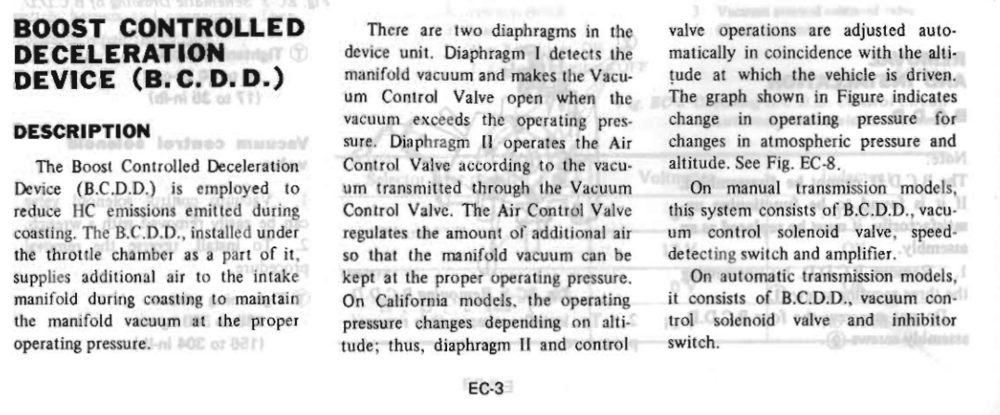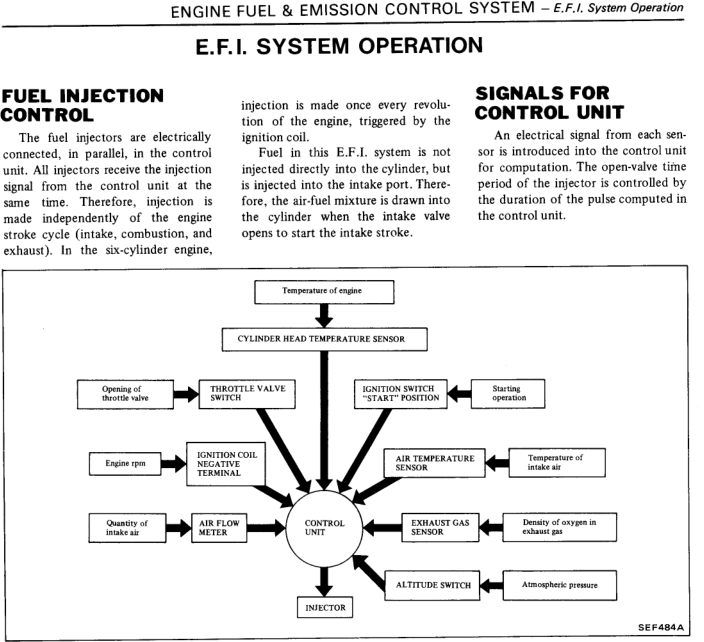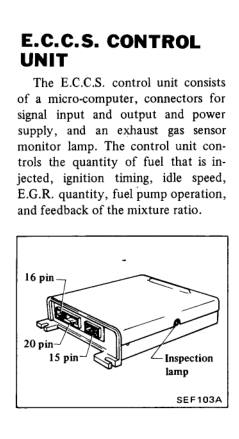Everything posted by Zed Head
-
Failed CO emissions - all controls removed - where to start?
Edit - responding to CO's post.... I can't tell what RPM that would be but I've wondered in the past about how much total advance might be seen under certain conditions. I had a distributor with "11" weights and a vacuum canister that gave 18, I think. So, 10 + 22 + 18 = 50 degrees. If I bumped my initial timing up to 14, I'd be at 54 degrees maximum. The centrifugal maxes out at about 2400 - 2500 RPM, commonly, so it's up there pretty quick. The vacuum curves are in the FSM. With your data you could probably put a map together, like the ones you use for programmable electronic control systems.
-
Failed CO emissions - all controls removed - where to start?
Very nice. But. I hate picking on people's hard word work, but the lowest RPM shown is 2300 RPM. Crack of the throttle should be down around 1000, I'd assume. As far as effect, the biggest might be that the timing advance to full vacuum advance setting. So timing probably jumps 18 degrees as soon as you crack the throttle.
-
Failed CO emissions - all controls removed - where to start?
Actually, you could describe the vacuum level on the port as matching manifold vacuum once the throttle blade opens. Zero when it's closed, manifold pressure (vacuum) once the blade moves. That's the simplest view. I think that Bernoulli, and Venturi's, principles have been discussed before as causing higher vacuum at the crack of the blade but I don't think that anyone has actually measured.it. So, really, it's just none and some.
-
Turbo vs Non-Turbo Camshafts - B vs F
You might double check the numbers using the FSM by year and model. They're in the Engine Mechanical chapter.
-
Spark plug reading
I was exaggerating with "wobble". It would have to be through the nose of the input shaft, which probably can't exert much force. The pilot bushing surface, the leverage point, is pretty small.
-
Failed CO emissions - all controls removed - where to start?
Yes, it goes to the distributor. Manuals and automatics both have vacuum advance timing also. The port on the throttle chamber is what they call "ported vacuum". It only has vacuum when the throttle is open, not at idle. The distributor's vacuum controlled timing advance and the carbon canister both use ported vacuum. Ported vacuum port on the throttle chamber goes to both the carbon canister and the distributor.
-
Failed CO emissions - all controls removed - where to start?
Sounds like somebody has messed with your vacuum lines and was unable to resist the urge to connect a vacuum line to the "Sorry:" piece. Not uncommon. The dashpot does not use vacuum, it's open to atmosphere. Make your vacuum lines look like the diagram. Get a three-way connector.
-
Spark plug reading
They're for "NVH" reduction, I believe. I think that stands for Noise, Vibration, Harmonics (or Harshness), They stop the transmission from wobbling around on the back of the block. Not going to help your oil leak but might make for a quieter ride.
-
79 280zx High Idle when warm
The guys were right, sounds like the BCDD. But the symptoms are odd. Usually they just stay at high idle, they don't correct on their own. Seems like yours might just be gummed up. It's the weird thing hanging under the throttle body. Later ZX's had them on the manifold.
-
Different ignition
Here it is. No post numbers in the thread, it's about 80% down the page. cygnusx1's post. https://forums.hybridz.org/topic/95316-braaps-l6-efi-induction-advice-and-tips/#comments @cygnusx1
-
Different ignition
So is there only one circuit board in the microprocessor ECU? Not a board sandwich like the early ones. Did they shrink the package down, the processor replacing a whole board's worth of components? Would be interesting to see what is connected to the processor. Might also be interesting to compare it to an ECCS ECU. See if it's a step on the progression. Somewhere out there is a list of what some of the components inside the early ECU's do, their functions. Resistors, capacitors, etc. superlen has seen it, I think. @superlen
-
79 280zx High Idle when warm
Is it a 5 speed or automatic? Your description doesn't quite fit. You're blending driving and idling together. Why would you be "at idle" going over 3 mph? Maybe add some details to what's happening? Hanging idle speed is pretty common but has several possible causes. Her's a service manual link.
-
Intermittent loss of compression
How about a valve seal? Maybe one bound up then tore. Might be able to see signs from under the valve cover.
-
Different ignition
EFI, ECU, microprocessor, "computer", "control",,, there are a lot of words being battered about here. The control algorithms coded in to the microprocessor circuitry would tell how much "computer control" was happening. Just because there's a microprocessor in the ECU doesn't mean it was "controlling" the whole system. It could be doing one small part, like handing the O2 sensor data. Response speed would be important for its role in the system. The original question was about the distributor being "computer controlled". Even if there is a microprocessor in one of the EFI ECU's, it wasn't used to control the ignition system. Just trying to keep things clear. Don't want to get in to this guys world - https://www.performancechiptuning.com/nissan/240z/
-
Are Burnouts an Appropriate Way for Mechanics to Road Test Cars?
Purely on the content that you posted. I've known and met people like that. His first words were a denial of something that he could not know, that the mechanic admitted doing burnouts. Then a justification of the thing that he said was not admitted to. I wouldn't trust that guy to work on anything of mine. You can't believe his words.
-
Are Burnouts an Appropriate Way for Mechanics to Road Test Cars?
Classic BS'ing. Art...
-
Are Burnouts an Appropriate Way for Mechanics to Road Test Cars?
Brad's a bullshitter.
-
Different ignition
Just realized that this thread is in Technical Articles. Probably shouldn't be. @Mike
- Different ignition
- Different ignition
-
Different ignition
-
Coil Pack Conversion - More Info Needed
It's clear. If I recall correctly, some engines have been built with a separate mechanical distributor for each spark plug. Mechanical COP. Lots of ways to redescribe something. Not sure which will help the discussion. At least we're splitting fuel from spark, which is always important for understanding.
-
Different ignition
Are we mixing the ECCS system with the EFI sysstem? The ECCS system was used on the turbo engines. Nissan went full ECCS on all engines in 1984, from my understanding, at least for the Z cars. Google found me an old article about it. https://trid.trb.org/view/183990
-
Coil Pack Conversion - More Info Needed
It does if you want to use it as wasted spark. The system pulls the spark from one plug and pushes it the other. The direction is the same whether it's on the power stroke or the exhaust stroke. It's pretty interesting to look at a set of plugs from a wasted spark engine. Half of them will have the center electrode burned down and the other will have wear on the grounding strap. It's weird.
-
My 280z will start and idle until i rev the engine
Ignition module failing is possible. Or you might be losing connection of the blue wire from the coil negative to the EFI, module, and tach. Sudden dying usually means no spark. Losing tach is sometimes a sign of module problems. Check for loose wires first.









